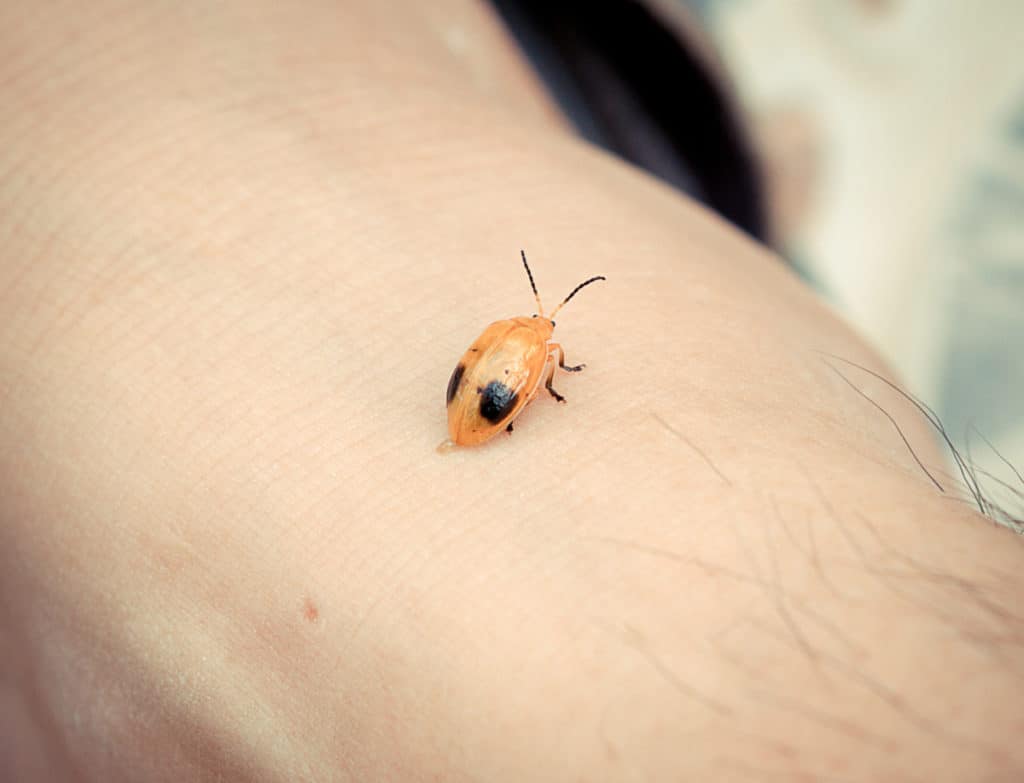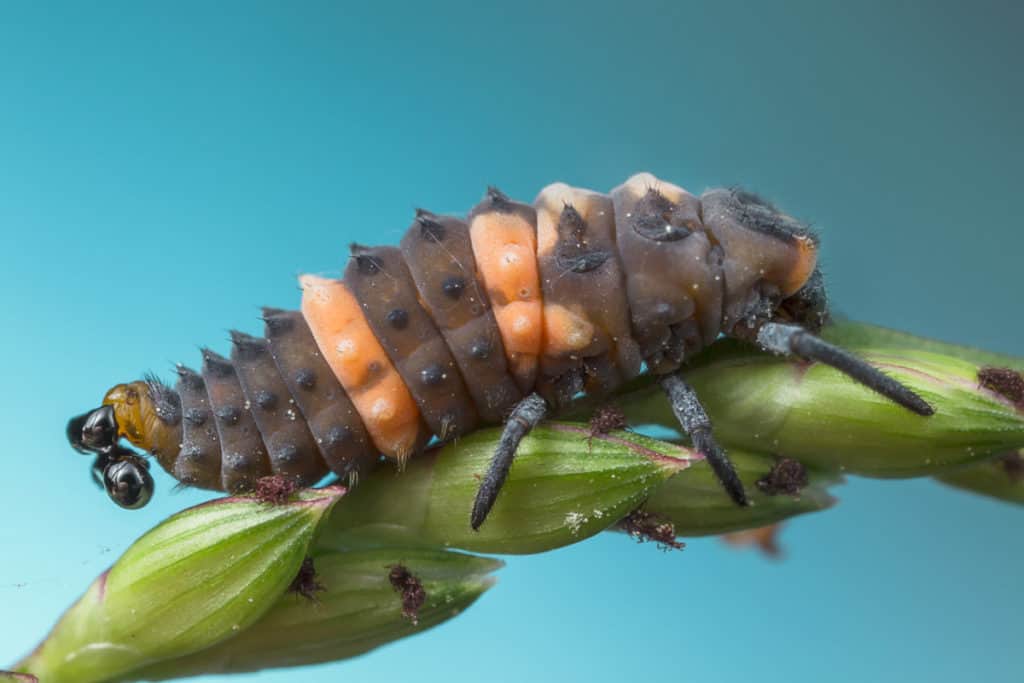They look so dainty and pretty, like a nursery rhyme come to life. And yet once you get to know a little bit more about them, you’ll find they’re full of surprises.
Like that gargantuan appetite, for example, their ability to fly great distances (these little marathon fliers have been known to remain airborne for as long as two hours) and their darker tendencies of munching on their very own unhatched siblings.
Given all these surprises, you’re most likely wondering what else they’re capable of with one question in particular which you’re probably not sure how to ask. As that’s why we’ll go right ahead and ask it anyway.
Do ladybugs poop? Yes, ladybugs do poop. They consume food that enters a digestive system that runs the length of their body. The digestive system has three parts, the foregut, the midgut, and the hindgut. Their poop exits the hindgut in the form of a small, solid but sticky little nugget.

Fun fact: insect poop also has its very own special name coined by scientists – frass.
So what are their bathroom habits like? Does the bathroom stink after they’ve used it? Why do they smell pretty awful at times, anyway? And what about baby ladybugs or larvae? Are they guilty of producing frass too?
Find out the answers to all these questions on this page dedicated to examining one of the most important yet often overlooked aspects of the most adorable beetle on the globe.
How Ladybugs Digest Their Food?
Most insects fall into one of two categories: those which have to suck up their food (e.g., mosquitoes and butterflies) and those who can chew it (e.g., ants, grasshoppers, termites, wasps).
Ladybugs being beetles, belong to the latter category and come equipped with mandibles. But why does any of this matter? Let’s begin with a look at their digestive system. Below, we have provided a brief overview of their mouthparts, foregut, midgut, and hindgut.
Mouthparts
Ladybugs get to ingest their food thanks to mouthparts made up of the following five components:
The hypopharynx – Insects’ tongue which enables them to mix their saliva with their food
The labium – A part that consists of fused maxillae and serves as their lower lip.
The labrum – This part serves as their upper lip and as a cover for their mouths.
The maxillae – Carry out a function that is similar to that of teeth and tongues in mammals: they hold the scale insect or whitefly in place and also enable the ladybird to enjoy its flavor.
The mandibles – Another word for insects’ jaws, these powerful mouthparts crush the ladybird’s food by moving side to side, rather than up and down as is commonly seen in mammals.
Honey bees also have teeth like mandibles that are used for performing many tasks. If you are interested check out this article we have written, Do Bees Have Teeth?
The Foregut
This is the first part of ladybugs’ alimentary canal (it was actually observed to be the shortest part of the gut in ladybirds of the two spot variety).
This part of the insect’s digestive system serves to transport food through the arthropod’s pharynx and esophagus to the proventriculus (a kind of insect gizzard) where it’s ground to bits.
The Midgut
It is here that the majority of digestive action takes place, thanks to enzymes released by the cells which form its lining. Scientists observed that this part was the longest in the two-spot ladybird.
The Hindgut
This part which brings up the rear is especially effective at drawing out water and salts from the food. As a result, it plays an important role in regulating the ladybird’s hemolymph (i.e., blood).
Over 90% of the water content of waste matter is drained in the hindgut before it is subsequently removed from the body.
So what happens once ladybugs have extracted every bit of goodness from scale insects, spider mites, and whiteflies? They get to go to the bathroom. Unlike certain insects that produce watery waste, theirs tends to be on the solid – if sticky – side.
And in the next section, we discuss where they rank in terms of bathroom habits on the insect hygiene scale.
What Are A Ladybugs’ Toilet Habits Like?
Certain insects are renowned for being especially fastidious in their bathroom habits. Honeybees are one such example. These hard-working little bugs, never, ever go to the bathroom indoors if they can help it and prefer to fly far away to do so.
Some species of cockroaches, surprisingly, also make it a point of duty to get rid of any frass in their tiny lairs.
Ladybugs, on the other hand, consider any surface within their vicinity fair game. As a matter of fact, they are not averse to leaving little trails of droppings as they go along. This means they will do their business on your veggies, and even closer to home, on your door frames, window ledges, and curtains, leaving loads of gooey blobs in their wake for you to clean up.
Is That Yellow, Foul-Smelling Stuff Ladybugs Release Wee?
Nope. It’s actually their hemolymph or blood. And they tend to release it whenever they sense danger is close. Which makes frightening them out of their wits a bad idea.
The process by which they can bleed at will and repel any possible predators in search of dinner is known as reflex bleeding.
Ladybug hemolymph may not be much of a problem when the tiny critters are out and about in your garden. However, it can be in the event of a winter invasion. Especially since they will leave telltale yellow stains which can be especially visible on white or pale surfaces.
Do Ladybug Larvae Poop?
Yes, they do. Just like the majority of larvae belonging to other insect species.

The fact that they do actually come as no surprise. Especially since this stage is one which is meant to be one of the most enjoyable of the future insect’s life thanks to all that eating – these armored little bugs in the making begin feeding once they emerge from their golden eggs and into the wide world.
The Wrap Up
The last thing you’d expect when looking at a ladybug is the fact that you might just be holding onto a tiny critter with carnivorous tendencies and poor bathroom hygiene. But that is exactly what these cute little beetles are.
They love nothing more than to eat and come fully equipped with the powerful mandibles and complex digestive system they need to process all that food efficiently and promptly.
This means they do poop – not necessarily a bad thing when it’s in your garden, but a bit of a nuisance when it’s on your freshly laundered curtains.
And that is just one more surprising aspect of these tiny beetles which are so much more than they seem to be at a glance.
Sources
https://genent.cals.ncsu.edu/bug-bytes/digestive-system/
